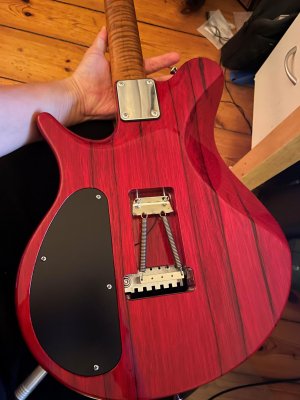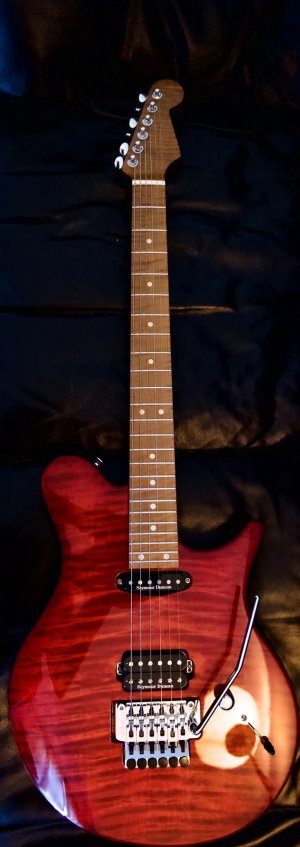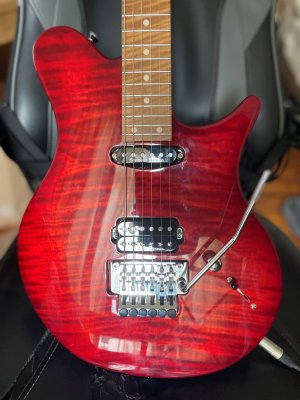johnnyj
Junior Member
- Messages
- 67
hi folks,
just finished my new velocity build which i created as a reminiscence to my old cane superstrat from the 90s.
the build is a roasted maple neck with 24 frets paired with a black korina body and a flamed top. for the neck i chose the 3a option. i oiled the neck with just two coats of tru oil. thanks alot to this community and specfic stratmanaia here for the advices that helped me alot in my preparation, this is really great. after i installed first two duncan pickups, i decided to use instead two older pickups of mine i have for many years. at the bridge it is now an dimarzio evolution, on the neck a SSL5 seymour duncan. the three way switch gets the middle position humbucker splitted with the single, so the position is hum free.
what i love about the build:
- the body looks awesome, and color looks great and ultra 3d (even if i expected a darker edge at corners because i selected a burst over). i was suprised how awesome the back of the guitar looked (transparent red korina). to have the back in this optical quality as the front would be absolutly okay for me too.
- when i unpacked the unfinished neck i was a bit disappointed because it somewhat looked dull. this disappointment quickly turned into very big happiness after i took on the two layers of tru oil. now the neck really looks awesome and feels great.
- the sustain behaviour of the guitar is very cool. hard to describe, but it has that magic sweetspot where it is not that hard to get a note to sing and sustain but still have the fast attack of a bolt on neck guitar, i love it.
- the sound of this combination is very pleasant. i would say it is a bit pronounced in the lower mids compared to my roasted alder warmoth, which is great for the stuff i play. riffs come out very tight and with a good inner stability (sorry for the lack of better description)
- guitar has no intonation issues and the earvarna nut works great
- the weight is suprisingly very good and heavy. i had the fear that it would be too light and the neck would tend to fall over, but the opposite is the case.
things i would do differently if i could turn back time when i spent two days in the warmoth gearbuilder:
- i was selecting the floyd NFT route and went with that tremolo initially. here in germany i had no option to test this in advance and really wanted to like it. unfortunately i found this unit very bad in tuning stability and flutter behaviour. all experiments with differnet setups, different arms, and different spring selections didnt make things better, so i switchted it for a schaller lockmeister. this was initially doing everything 200% better. unfortunaltey it is a slightly tad smaller on one side, leaving an unpleasant little space, but the tone and playability increase is worth it. i had to change the rear screws of the schaller because it didnt fit originally in the cave. but since i use it without double locking and dont need the finetuners, i removed the spring plate that presses the screws upwards and locked the fine tuner screws tight, which might give the whole setup even more stability, since there are no moving parts at the trem anymore and the finetuner screws now press hard on the string saddle elements. tuning stability is now great. as much as i investigated anything, i dont understand why the floyd fails that hard, the construction looks simple and well done and the warmoth stud spacing came also perfect.
lesson learnt: should have trusted in my beloved schallers and directly get this route. my schaller knifeedges never failed, even on a guitar i tortured with heavy flutter divebomb madness for 10 years, this seem to make a difference to many other units.
- i positioned the lever symetrically with the volume poti because of looks. this looks very nice but is a bit impractical, since you have a little bit issues to quickly turn it from neck to bridge because the vol pot is now in the way. lesson learnt: positioning of lever and poti should be a bit asymetrical for better switching ergonomy.
- velocity body selection: i had high hopes in the ergonomical advantages of the design here but was a bit disappointed. for some reason, the upper horn that touches your torso when playing is a bit uncomfortable compared to a warmoth tele with the same cutaways. i cant really explain why, they look very similar but i can feel a difference here. so when playing it on my leg, the part that touches my torso is the end part of the horn which is not the cutaway part. but thats just a minor issue, and maybe just is for me and my posture. i assume the bigger your belly is, the more you will grow into the comfortability sweetspot of the velocity. so i guess i have to order some pizzas. a bigger issue is that indeed the accessability of the 23 and 24 frets is really bad. i would say this is not any better than on my warmoth tele at all. this is mainly because of the very fat neck joint that hinders the hand for access. if i would build with warmoth again, i would stay away from 24 fret builds, this is not comparable to superstrats that are designed for shred access in upper registers.
a bigger issue is that indeed the accessability of the 23 and 24 frets is really bad. i would say this is not any better than on my warmoth tele at all. this is mainly because of the very fat neck joint that hinders the hand for access. if i would build with warmoth again, i would stay away from 24 fret builds, this is not comparable to superstrats that are designed for shred access in upper registers.
- 720 mod. i originally wanted to do it, but many people including warmoth sales recommended to not do it, so i followed this recommendation in the end. for this build i could surely have done it without issues, but i understand the issues it could cause in other circumstances. i was very afraid that i would hate the open gap of the fret overhang first but i have to say that it doesnt bother me anymore after some days of getting used to the look.
so this looks like a long list of negatives, but i just wanted to write it down for future people in deciding phase who might have the same questions in mind.
overall, i consider this guitar as a succes and i play it now everyday many hours with great joy, so i am happy.
here are some pictures and a video of some metalcore riffing. i will post soon another video with more pleasant and less distorted music for all of you non-metalheads.
cheers
johnny
just finished my new velocity build which i created as a reminiscence to my old cane superstrat from the 90s.
the build is a roasted maple neck with 24 frets paired with a black korina body and a flamed top. for the neck i chose the 3a option. i oiled the neck with just two coats of tru oil. thanks alot to this community and specfic stratmanaia here for the advices that helped me alot in my preparation, this is really great. after i installed first two duncan pickups, i decided to use instead two older pickups of mine i have for many years. at the bridge it is now an dimarzio evolution, on the neck a SSL5 seymour duncan. the three way switch gets the middle position humbucker splitted with the single, so the position is hum free.
what i love about the build:
- the body looks awesome, and color looks great and ultra 3d (even if i expected a darker edge at corners because i selected a burst over). i was suprised how awesome the back of the guitar looked (transparent red korina). to have the back in this optical quality as the front would be absolutly okay for me too.
- when i unpacked the unfinished neck i was a bit disappointed because it somewhat looked dull. this disappointment quickly turned into very big happiness after i took on the two layers of tru oil. now the neck really looks awesome and feels great.
- the sustain behaviour of the guitar is very cool. hard to describe, but it has that magic sweetspot where it is not that hard to get a note to sing and sustain but still have the fast attack of a bolt on neck guitar, i love it.
- the sound of this combination is very pleasant. i would say it is a bit pronounced in the lower mids compared to my roasted alder warmoth, which is great for the stuff i play. riffs come out very tight and with a good inner stability (sorry for the lack of better description)
- guitar has no intonation issues and the earvarna nut works great
- the weight is suprisingly very good and heavy. i had the fear that it would be too light and the neck would tend to fall over, but the opposite is the case.
things i would do differently if i could turn back time when i spent two days in the warmoth gearbuilder:
- i was selecting the floyd NFT route and went with that tremolo initially. here in germany i had no option to test this in advance and really wanted to like it. unfortunately i found this unit very bad in tuning stability and flutter behaviour. all experiments with differnet setups, different arms, and different spring selections didnt make things better, so i switchted it for a schaller lockmeister. this was initially doing everything 200% better. unfortunaltey it is a slightly tad smaller on one side, leaving an unpleasant little space, but the tone and playability increase is worth it. i had to change the rear screws of the schaller because it didnt fit originally in the cave. but since i use it without double locking and dont need the finetuners, i removed the spring plate that presses the screws upwards and locked the fine tuner screws tight, which might give the whole setup even more stability, since there are no moving parts at the trem anymore and the finetuner screws now press hard on the string saddle elements. tuning stability is now great. as much as i investigated anything, i dont understand why the floyd fails that hard, the construction looks simple and well done and the warmoth stud spacing came also perfect.
lesson learnt: should have trusted in my beloved schallers and directly get this route. my schaller knifeedges never failed, even on a guitar i tortured with heavy flutter divebomb madness for 10 years, this seem to make a difference to many other units.
- i positioned the lever symetrically with the volume poti because of looks. this looks very nice but is a bit impractical, since you have a little bit issues to quickly turn it from neck to bridge because the vol pot is now in the way. lesson learnt: positioning of lever and poti should be a bit asymetrical for better switching ergonomy.
- velocity body selection: i had high hopes in the ergonomical advantages of the design here but was a bit disappointed. for some reason, the upper horn that touches your torso when playing is a bit uncomfortable compared to a warmoth tele with the same cutaways. i cant really explain why, they look very similar but i can feel a difference here. so when playing it on my leg, the part that touches my torso is the end part of the horn which is not the cutaway part. but thats just a minor issue, and maybe just is for me and my posture. i assume the bigger your belly is, the more you will grow into the comfortability sweetspot of the velocity. so i guess i have to order some pizzas.
- 720 mod. i originally wanted to do it, but many people including warmoth sales recommended to not do it, so i followed this recommendation in the end. for this build i could surely have done it without issues, but i understand the issues it could cause in other circumstances. i was very afraid that i would hate the open gap of the fret overhang first but i have to say that it doesnt bother me anymore after some days of getting used to the look.
so this looks like a long list of negatives, but i just wanted to write it down for future people in deciding phase who might have the same questions in mind.
overall, i consider this guitar as a succes and i play it now everyday many hours with great joy, so i am happy.
here are some pictures and a video of some metalcore riffing. i will post soon another video with more pleasant and less distorted music for all of you non-metalheads.
cheers
johnny






